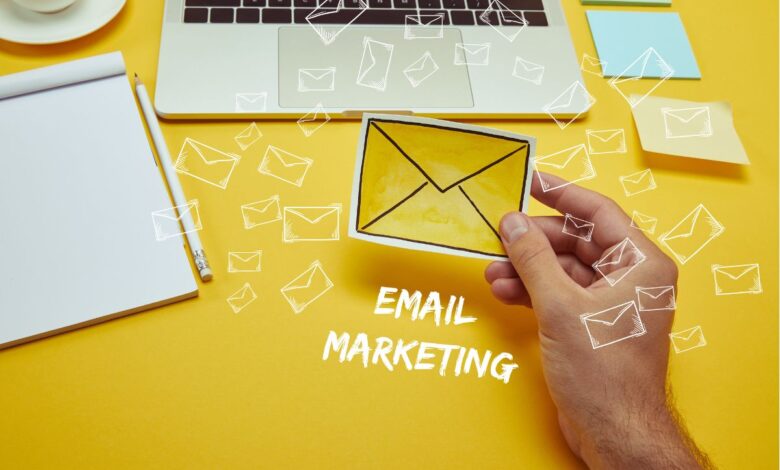Creating A Successful Email Marketing Campaign A Step By Step Guide

Email marketing campaigns can be a powerful tool for businesses looking to increase their reach and drive sales. However, creating an effective campaign requires more than just sending out a mass email to your entire list of subscribers. To create a successful email marketing campaign, you need to develop a strategy that will engage your audience and encourage them to take action.
In this step-by-step guide, we’ll walk you through the process of creating an email marketing campaign from start to finish. From developing your goals and target audience to crafting compelling subject lines and calls to action, we’ll cover everything you need to know to make sure your emails are getting read and driving results.
Whether you’re new to email marketing or just looking for ways to improve your current approach, this guide is designed to help you succeed. So grab a cup of coffee and let’s dive in!
Define Your Target Audience And Goals
Before diving into the creation of an email marketing campaign, it is essential to define your target audience and goals. This euphemistic process will help you achieve a successful outcome by curating campaigns that are tailored to specific groups, resulting in higher engagement rates.
Firstly, identifying your target audience involves understanding their demographics, interests, preferences and pain points. Creating customer personas can be helpful in this case as they provide you with a clear picture of who your customers are and what motivates them. Through detailed research or surveys, you can gather information about their buying habits and behavior patterns which will guide you in designing effective email campaigns.
Secondly, setting measurable goals for each campaign is necessary for evaluating its success. These goals could range from increased website traffic to growing the subscriber list or boosting sales numbers. The key here is to make sure these objectives align with your business strategy while being realistic and achievable.
By defining your target audience and goals at the beginning stages of creating an email marketing campaign, you set yourself up for success. The next step would be segmenting your email list based on relevant criteria such as location, age group or purchasing history- enabling personalized content delivery that resonates better with subscribers’ needs.
Segment Your Email List
Segmenting your email list is a crucial step in creating a successful email marketing campaign. You may have an extensive list of subscribers, but not all of them will be interested in the same content. By segmenting your list based on demographics, behavior or interests, you can tailor your emails to specific groups and increase engagement.
Firstly, consider demographic segmentation. This involves dividing your list into groups based on characteristics such as age, gender, location, or job title. For instance, if you’re promoting a product that’s only available in certain regions, you’ll want to send targeted messages to those who live there instead of spamming everyone on the list.
Secondly, behavioral segmentation looks at how subscribers interact with your brand. It could be their purchase history or website activity – this data helps you identify what type of content resonates with each group. If someone has already bought from you before, they might appreciate exclusive offers or rewards that aren’t relevant to new subscribers.
Lastly, interest-based segmentation takes into account people’s hobbies and preferences. For example, customers who are fans of fitness products would respond better to workout suggestions than general health tips. Similarly, pet owners would likely open emails about pet food sales more readily than other promotions.
By giving different types of information to various subsets of your audience through email segmentation tactics like those mentioned above (demographic/behavioral/interest), it can help drive conversions by keeping messaging focused and engaging for each subscriber.
In conclusion (oops!), now that we’ve covered why segmenting is important let’s move on to choosing the right email marketing platform which is equally vital when it comes to executing campaigns effectively!
Choose The Right Email Marketing Platform
Have you ever tried sending an email campaign to your customers or subscribers, only for it to end up in their spam folder? Or worse, have no one even bother opening your email? It’s frustrating and discouraging. But fear not, because choosing the right email marketing platform can make all the difference.
Think of an email marketing platform as a hammer – there are many different types of hammers with various functionalities, but if you choose the wrong type for the job at hand, you’ll find yourself struggling to get anything done. Similarly, picking the wrong email marketing platform can hinder your progress and affect your success rate.
When selecting a platform, consider what features are most important to you – do you need automation capabilities or detailed analytics? Are customizable templates crucial or is ease of use more important? Take time to research different options and read reviews from other users before making a decision.
One popular option is Mailchimp which offers a user-friendly interface and has a wide range of templates available. Another great choice is Constant Contact which provides excellent support services and advanced segmentation options. Both platforms offer free trials so that you can test out their features before committing.
Ultimately, choosing the right email marketing platform will save you time and effort while increasing engagement rates with your audience. Don’t underestimate its importance in creating a successful campaign!
Now that we’ve covered how to choose the right platform for your needs let’s move on to designing an attractive template that will capture your subscriber’s attention.
Design An Attractive Email Template
Did you know that emails with personalized subject lines have a 29% higher open rate than those without? That’s why designing an attractive email template is crucial for the success of your email marketing campaign.
Firstly, choose a template that aligns with your brand identity and message. Keep in mind that simplicity is key when it comes to design. Too many images or graphics can overwhelm the reader and distract them from the main purpose of your email.
Next, ensure that your content is easy to read by using clear fonts and formatting techniques such as headings and bullet points. Make sure your call-to-action stands out by using contrasting colors or bolding.
Moreover, optimize your email for mobile devices since more than half of all emails are opened on smartphones or tablets. This means keeping the layout simple and ensuring that images are compressed to load quickly on smaller screens.
By following these tips, you can create an aesthetically pleasing email template that not only grabs attention but also effectively communicates your message.
Transitioning into the next section about crafting a compelling subject line, remember that while design is important, it’s equally essential to entice readers with an intriguing subject line.
Craft A Compelling Subject Line
Imagine your email is a book. The subject line is the title, and just like with books, if the title isn’t captivating enough, readers won’t bother opening it up to read further. Crafting a compelling subject line is crucial for creating a successful email marketing campaign.
The first step in crafting an effective subject line is understanding who your target audience is and what they’re interested in. Personalizing the subject line to their interests can increase open rates and engagement. Additionally, keeping the subject line short and sweet will make it easier for recipients to understand at a glance what your email contains.
Another tactic that can make your subject lines more engaging is using urgency or scarcity language – phrases such as “limited time offer” or “don’t miss out.” This creates a sense of FOMO (fear of missing out) which compels people to take action quickly.
It’s also important to avoid clickbait-style headlines that are misleading or overly sensationalized. These types of subject lines may get initial opens but ultimately lead to unsubscribes or spam complaints.
In summary, crafting an attention-grabbing subject line requires understanding your audience, personalization, brevity, urgency/scarcity language without going overboard, and avoiding clickbait. With these tactics in mind, you’ll be able to create compelling titles that entice readers into opening your emails and finding out more about what you have to say.
As we move on to the next section about personalizing emails even further for maximum impact let’s keep this allegory in mind- Just like how every reader has different tastes when picking up a book off the shelf so do our subscribers have unique preferences when receiving promotional messages through their inbox!
Personalize Your Emails
As you craft your email marketing campaign, remember that personalization is key. By catering to each individual recipient’s interests and needs, you increase the likelihood of engagement and conversion.
One way to personalize your emails is by including the recipient’s name in the greeting or subject line. This small touch creates a sense of familiarity and connection with the reader. Additionally, segmenting your email list based on demographics or previous interactions allows for targeted messaging that speaks directly to their unique situation.
But personalization goes beyond just using someone’s name. Consider tailoring the content of your emails to match their preferences and behaviors. Use data analytics tools to gain insight into what types of products or services they’ve shown interest in before, and adjust your messaging accordingly.
By taking these steps towards personalization, you can create an experience that feels tailor-made for each individual recipient rather than a generic blast sent out en masse.
So as you move forward in crafting engaging and effective copy for your email marketing campaign, keep this focus on personalization at top of mind. It will set you apart from other campaigns vying for attention in crowded inboxes and help establish meaningful connections with potential customers.
Write Engaging And Effective Copy
Writing engaging and effective copy is a crucial step in creating a successful email marketing campaign. Your words have the power to captivate your audience, evoke emotions, and ultimately drive them to take action. Think of your emails as an opportunity to tell a story, connect with your readers on a personal level, and offer something of value.
To begin with, start by crafting an attention-grabbing subject line that entices your reader to open the email. Consider using vivid language or asking thought-provoking questions that pique their curiosity. Once you’ve got their attention, make sure the body of your email delivers on the promise made in the subject line. Keep it concise, use simple language that’s easy to understand, and avoid any jargon or overly technical terms.
Moreover, try incorporating storytelling techniques into your writing style. Use anecdotes or examples that illustrate how your product or service has helped others solve similar problems or meet specific needs. This helps create empathy between you and your readers while also positioning yourself as a trusted authority in your industry.
Finally, don’t forget about including a clear call-to-action (CTA) at the end of each email. Whether you want them to click through to learn more about a promotion or sign up for a newsletter subscription list, make it easy for them to act upon what they’ve just read.
By following these steps, you can write compelling copy that resonates with your audience while motivating them towards action – all within the context of an effective email marketing campaign!
Include A Clear Call to Action
Including a clear call to action in your email marketing campaign is crucial to its success. You may have written the most engaging and effective copy, but without a clear next step for your audience, they may not take any action at all. A call-to-action tells your readers exactly what you want them to do after reading your email.
To create an effective call-to-action, consider the goal of your campaign and what action you want your audience to take. Do you want them to visit your website? Make a purchase? Sign up for a newsletter. Whatever it is, make sure it’s clear and easy for them to follow through on.
One way to make your call-to-action stand out is by using contrasting colors or bolding the text. This draws attention to the button or link that leads to the desired action. Another tip is to use urgent language such as “limited time offer” or “act now” to encourage immediate action.
By including a clear call-to-action in your email marketing campaign, you increase the chances of conversion and achieving your goals. But don’t stop there – optimize your emails for mobile devices in order to reach even more potential customers.
Optimize For Mobile Devices
When it comes to email marketing campaigns, optimizing for mobile devices is a crucial step in ensuring success. In today’s world where people are always on the go and rely heavily on their smartphones, emails that don’t display properly on smaller screens can be easily dismissed or deleted.
To optimize your email campaign for mobile devices, start by using responsive design templates that automatically adjust to different screen sizes. This will ensure that your emails look great no matter what device they’re being viewed on. It’s also important to keep your subject lines short and impactful since mobile users tend to scan quickly before deciding whether or not to engage with an email.
Another way to optimize for mobile is by prioritizing the most important information at the top of your email so it can be seen without scrolling too much. Use clear headings and subheadings along with bullet points to break up large chunks of text.
By taking these steps, you’ll increase the chances of your audience engaging with your content regardless of where they’re accessing it from. And now that you’ve optimized your email for mobile devices, it’s time to test and refine your campaign even further.
As you move into testing and refining, consider using A/B testing techniques to see which elements resonate best with your audience. This could include trying out different subject lines, calls-to-action (CTAs), or sending times. With each round of testing, take note of what worked well and what didn’t so you can make informed adjustments moving forward.
Remember: creating a successful email marketing campaign doesn’t happen overnight – it takes time, effort, and ongoing refinement. But by optimizing for mobile devices and continually testing and refining your approach, you’ll be well on your way toward achieving your goals.
Test And Refine Your Email Campaign
You’ve optimized your email campaign for mobile devices, but how do you know if it’s truly effective? That’s where testing and refining come in. It’s a common misconception that once an email is sent out, the work is done. But to create a successful campaign, you need to continuously test and refine your approach.
Firstly, start with A/B testing. This involves creating two versions of an email—one with a certain element changed—and sending them both to different segments of your audience. Once you have a winner (the version that performed better), use that as the base for future emails.
Next, analyze your data. Look at open rates, click-through rates, conversion rates, and even unsubscribe rates. These metrics will tell you which parts are resonating with your audience and which aren’t.
Finally, don’t be afraid to make changes based on what you learn from testing and analyzing. The beauty of email marketing is its flexibility—you can always adjust the course mid-campaign if necessary. By continually fine-tuning your strategy based on real results, you’ll see improved performance over time.
With these steps in mind, let’s move on to measuring and analyzing your results—where we’ll dive deeper into specific metrics to track and ways to interpret them effectively.
Measure And Analyze Your Results
Measuring and analyzing your email campaign results is crucial to its success. According to a recent study, 80% of marketers say that measuring email marketing effectiveness is a challenge. However, it’s important to overcome this challenge as the insights gained can help you improve future campaigns.
To start with, analyze open rates and click-through rates (CTR) for each email in the campaign. This will give you an idea of what subject lines and content resonated best with your audience. You can also track conversion rates if you have included calls-to-action (CTAs) in your emails. By identifying which CTAs generated more clicks or conversions, you can optimize them for better results.
It’s not just about looking at individual metrics; it’s equally essential to look at how they relate to each other. For instance, did higher open rates lead to increased CTRs? Did certain segments perform better than others? Segmenting data by demographics, location, or behavior can provide valuable insights into customer preferences.
In conclusion, analyzing the performance of your email campaign provides invaluable feedback on which aspects worked well and where there is room for improvement. Armed with these learnings, you can automate your email campaigns for even greater efficiency and impact.
Automate Your Email Campaigns
Automating your email campaigns is a crucial step toward making them more effective and efficient. With automation, you can save time while still reaching out to customers regularly. There are many different types of automated emails that you can create, such as welcome messages, abandoned cart reminders, and birthday greetings.
To get started with automating your email campaigns, first identify the types of emails that would be most beneficial for your audience. Then, use an email marketing platform that allows you to set up triggers and rules for each type of email. This will ensure that the right message goes out at the right time based on user behavior or other criteria.
Another benefit of automation is the ability to personalize your messages without having to manually send individual emails. Many platforms have features like merge tags or dynamic content blocks that allow you to insert customer information into each message automatically. This personal touch can increase engagement and help build stronger relationships with your subscribers.
However, it’s important not to rely too heavily on automation and forget about manual outreach efforts. A balance between automated and personalized messaging should be maintained in order to keep subscribers interested and engaged over time.
In conclusion, automating your email campaigns can greatly improve their effectiveness by saving time and adding personalization. By using an email marketing platform with trigger-based rules and personalized content options, businesses can easily reach out to customers with relevant messages at the right times. Just remember not to sacrifice the human touch entirely for convenience’s sake – a combination of both automated and manual outreach is key!
In conclusion
Creating a successful email marketing campaign requires careful planning and execution. Crafting a compelling subject line is like the front door of your house – it’s the first thing people see and can make or break their interest in what’s inside. Personalizing your emails adds that personal touch, like a warm hug from an old friend. Writing engaging and effective copy is like telling a story that captures your audience’s attention and keeps them wanting more. And including a clear call to action is like handing someone a map to guide them toward taking meaningful action.
Remember, these steps are just the beginning of crafting an effective email marketing campaign. With patience, perseverance, and creativity, you can build relationships with your subscribers and turn leads into loyal customers. So don’t be afraid to experiment with different strategies until you find what works best for you and your business. Happy emailing!




